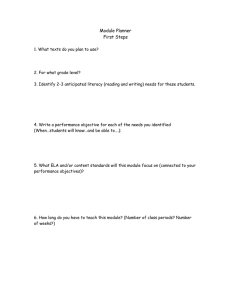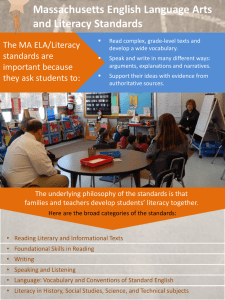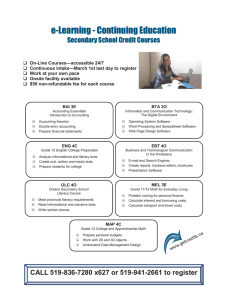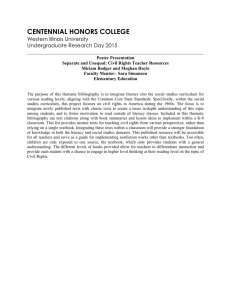Enduring Understandings We believe a literate person:
advertisement
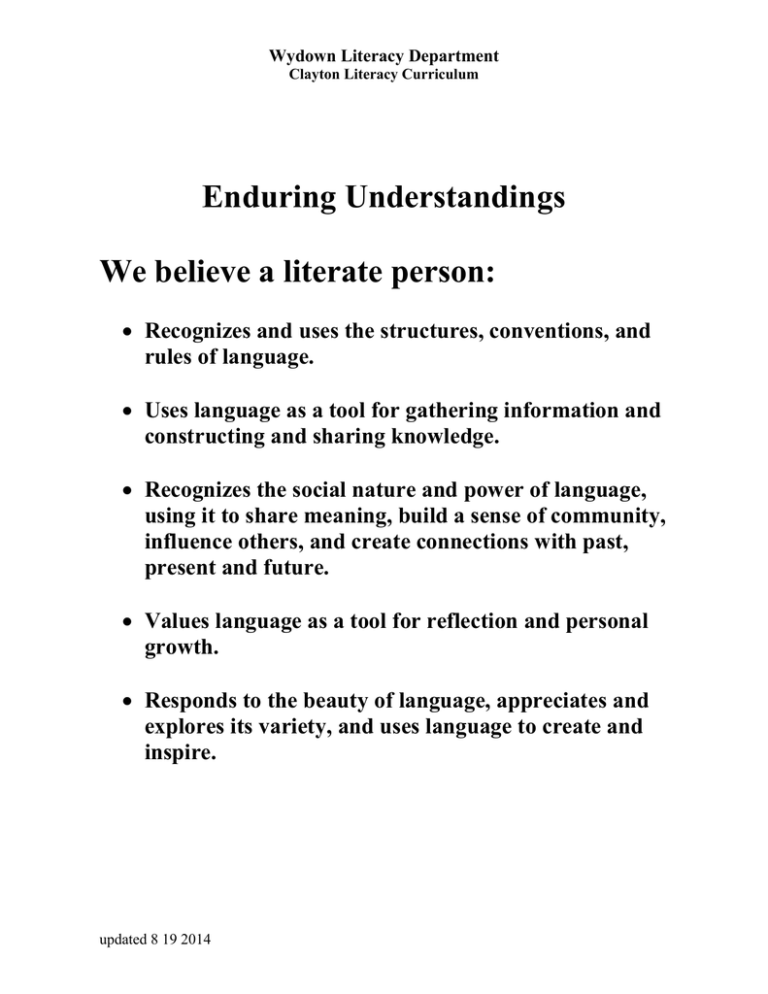
Wydown Literacy Department Clayton Literacy Curriculum Enduring Understandings We believe a literate person: Recognizes and uses the structures, conventions, and rules of language. Uses language as a tool for gathering information and constructing and sharing knowledge. Recognizes the social nature and power of language, using it to share meaning, build a sense of community, influence others, and create connections with past, present and future. Values language as a tool for reflection and personal growth. Responds to the beauty of language, appreciates and explores its variety, and uses language to create and inspire. updated 8 19 2014 Wydown Literacy Department Clayton Literacy Curriculum Essential Classroom Practices Literacy classrooms at WMS incorporate a wide range of reading and writing experiences supported by rich conversation. In addition, drama, film and multimedia texts play an important role in the language and literacy development of our students. While each classroom reflects the particular strengths, personalities, and interests of the individual teachers and students in the classroom, all literacy classrooms at WMS share a set of common curricular structures: Essential Classroom Practices. These practices provide structure to the way students engage with the content. The essential classroom practices include: Shared Reading Independent Reading Assigned Writing Writers Workshop Inquiry Demonstration and Celebration Discussion Within each quarter of the school year, students are involved in each of these essential practices although they may not occur each day or even each week. updated 8 19 2014 Wydown Literacy Department Clayton Literacy Curriculum Shared and Independent Reading Reading experiences at Wydown include reading across disciplines and in a variety of print and non-print materials. In the Literacy classrooms, students engage in both Shared Reading of common texts and Independent Reading of self-selected texts. All students are Wydown are expected to read outside of school from both Shared Reading and Independent Reading materials. Goals of Shared and Independent Reading include expanding the range of texts that students read, increasing the sophistication of texts that students can read effectively, and promoting a life-long habit of reading for various purposes. Characteristics Shared Reading experiences at Wydown: Focus on core literature selections, as well as other titles Use single texts (Core literature) or multiple texts (textsets) Provide a shared experience that students can draw upon in the future Provide instructional opportunities, particularly in relation to conventions of written language, elements of fiction, and characteristics of various genre Use a variety of group sizes: partners, small, large or whole Develop shared vocabulary and provide for specific vocabulary study Highlight author’s craft and provide models for writing Highlight the reading/responding/analyzing process and provide opportunities for students to see, value and use effective reading comprehension strategies for before, during and after reading Independent Reading experiences at Wydown: Focus on self-selected texts, often reflecting a particular genre or topic Encourage wide reading Provide opportunities for students to share titles with one another Encourage life-long reading habits Require out-of-school time spent reading Encourage independent use of reading strategies Supplement and extend the Shared Reading experiences Provide models for writing Critical Routines: Critical routines for Shared and Independent Reading vary from classroom to classroom and include a variety of strategies depending upon the needs of the students and the nature of the reading tasks and the texts. Although the amount of time devoted to each will vary from classroom to classroom, all WMS students work with the following as part of their reading experiences: Read-aloud of full texts and excerpts Reading logs or records of texts read Guided and Supported Reading to promote effective use of reading strategies Literature discussions with partners and in large and small groups to respond to, interpret and analyze texts Literature extension experiences to encourage revisiting texts and deeper analysis of texts Literature response logs to encourage active reading and critical analysis of texts updated 8 19 2014 Wydown Literacy Department Clayton Literacy Curriculum Shared Reading As part of Shared Reading, students engage in extensive study of three Core Literature titles as well as other reading selections. The required selections for Sixth Grade at Wydown Middle School include: Bamboo People by Mitali Perkins Roll of Thunder, Hear My Cry by Mildred Taylor Where the Red Fern Grows by Wilson Rawls Our Shared Reading experiences center around the following Essential Questions: First Semester: Who am I? Where do I belong? How does where you live affect how you live? Second Semester: Why do people behave the way they do? How do the decisions and actions of an individual affect others? Independent Reading In middle school, we believe it is important for students to read for pleasure, in materials of their own choosing. Generally, Wydown Middle School students should be reading on their own in self-selected materials for at least 30 minutes several times per week. Independent reading provides opportunities to practice reading strategies they have learned, supports development of vocabulary, and develops background knowledge on a range of topics. An important part of becoming a lifelong reader is learning how to select books and other reading materials. For this reason, our middle school students are encouraged to engage in independent reading with a variety of books and materials, without being limited to certain levels. We encourage our middle school students to reread familiar books and to read a wide range of materials including picture books, magazines, newspapers, and online texts. Regular opportunities to visit a library – a public library or our school library, help readers appreciate the variety of books and materials available for reading. updated 8 19 2014 Wydown Literacy Department Clayton Literacy Curriculum Assigned Writing and Writers Workshop The writing assignments in Literacy classes at Wydown include informal writing such as freewrites, writing warm-ups, notes, reflections/responses, summaries and other uses of writing to learn and organize ideas. Major writing assignments include both assigned writing topics and self-selected writing topics. A writing workshop environment provides opportunities for students to engage in the writing process: prewriting, drafting, sharing, revising, conferencing, editing and publishing. Working with peers and teachers is an essential part of the writing process. Conventions of written language (spelling, punctuation, grammar, usage, formatting) are highlighted during mini-lessons or focus lessons and then addressed primarily during the editing phase of the writing process. Characteristics Writing experiences at Wydown: Specify topic, rhetorical context, style, and/or genre Include shared vocabulary and develop shared understanding about quality in writing Include synthesis and application to learning Emphasize conventions and roles used in various contexts Include application of conventions, including grammar, spelling, and punctuation Encourage reflection Use and build content vocabulary Accommodate student choice and voice Provide students with opportunities to experiment with a variety of genres Challenge students to go beyond comfortable writing practices Use the writing process, including sharing with others and peer collaboration Require thinking and planning Allow for a variety of topics Provide opportunities for reading, speaking, listening, and questioning Model the craft of writing Invite students to revisit and rework published drafts at a later time and at a different level Critical Routines: Critical routines for writing vary from classroom to classroom and include a variety of strategies depending upon the needs of the students and the nature of the writing tasks. Although the amount of time devoted to each will vary from classroom to classroom, all WMS students work with the following strategies as part of their writing experiences: Journal writing Daily edits Prewriting strategies Drafting Conferencing with peers and/or teacher Editing Mini-lessons Publishing Reflection Responding to a variety of text and non-text experiences Scoring Guides/Rubrics updated 8 19 2014 Wydown Literacy Department Clayton Literacy Curriculum The Multi-Draft Writing Process In middle school, we value the process of writing – developing topic ideas, creating initial drafts, working alone and with others to revise and then edit these drafts, and sharing completed work with others. Wydown students write in all of their courses, and their teachers help them make connections between their reading and writing. Throughout the year, students write for a variety of purposes and in a variety of genres to develop their logical thinking and their own sense of style and voice. While some writing assignments are taken through the entire writing process, others are designed to highlight only particular parts of the process. During the revision process, students work toward more sophisticated understanding of both the topics they are writing about and the various ways to present information and arguments. This part of the writing process benefits critical thinking. While editing, students work on capitalization, punctuation, spelling, and grammar to increase the clarity of their message. Demonstration and Celebration The Literacy Curriculum at Wydown provides opportunities for students to use oral and written language to demonstrate and celebrate their learning. Demonstrations of learning might include using writing to show new understandings, creating visual images of abstract concepts developed through literature study, making presentations to a class or group, or organizing a portfolio that highlights new areas of growth and documents the range of work completed. Demonstrations of learning involve the creation of artifacts that can be used to document growth. Reflecting on growth includes consideration of both product and process. Students evaluate the artifacts they create as readers and writers as well as the processes they are using to create those artifacts. Demonstration and Celebration includes using language for documenting, assessing, reflecting and goal-setting Discussion The Literacy Curriculum at Wydown provides opportunities for students to use Discussion as a tool for learning in reading, writing and other areas of study. Students develop discussion skills in other classes as well. Discussion includes learning more sophisticated strategies for creating agendas for discussion, engaging in productive discussions that result in increased learning for all participants, and reflecting on the effectiveness of discussions. Listening, speaking and reflecting are critical components of Discussion. Inquiry The Literacy Curriculum at Wydown reflects awareness of the critical role that language plays in the learning process. Language is an essential tool for making and sharing meaning. In Literacy classes as well as other subject areas, students develop more sophisticated strategies for posing and pursuing questions about a range of topics, including about language itself. Critical inquiries in the Literacy classroom include studying the way language works, vocabulary, the craft of writing, the characteristics of genre, and the ways that literature illuminates life. updated 8 19 2014
